Inquiry UI Locate
The Inquiry UI API has been implemented for improving the performance of the Business Service Console. The basic idea is to retrieve data that appear in the Business Service Console using a single API call.
This API contains only one operation get_entityDetail. Its input includes a query specification and an output format:
The query specification comprises one of the standard UDDI v3 API data structures: find_business, find_services, find_binding, find_tModel, get_businessDetail, get_serviceDetail, get_bindingDetail and get_tModelDetail.
The output format defines which data structures will be returned and how they will be pruned.
The operation get_entityDetail returns a list of UDDI data structures. ACLs are also applied to retrieved data.
For example, if you specify the following inquiry:
<get_entityDetail xmlns="http://systinet.com/uddi/inquiryUI/6.0">
<outputFormat>
<businessEntityMask descriptionIncluded="true" identifierBagIncluded="true"/>
<businessServiceMask descriptionIncluded="true"/>
</outputFormat>
<find_binding serviceKey="uddi:systinet.com:demo:hr:employeesList"
xmlns="urn:uddi-org:api_v3"/>
</get_entityDetail>You will receive the following output:
<entityDetail xmlns="http://systinet.com/uddi/inquiryUI/6.0">
<businessEntity businessKey="uddi:systinet.com:demo:hr"
xmlns="urn:uddi-org:api_v3">
<name>HR</name>
<description>HR department</description>
<businessServices>
<businessService serviceKey="uddi:systinet.com:demo:hr:employeesList"
businessKey="uddi:systinet.com:demo:hr">
<name>EmployeeList</name>
<description>wsdl:type representing service</description>
</businessService>
</businessServices>
<identifierBag>
<keyedReference tModelKey="uddi:systinet.com:demo:departmentID"
keyName="department id" keyValue="002"/>
</identifierBag>
</businessEntity>
</entityDetail>If there are matching bindingTemplates accessible while associated businessServices are not (because of ACLs), such bindingTemplates will be included in the result in a separate list of bindingTemplates. The same behavior applies to accessible businessServices of inaccessible businessEntities.
Data Structures Locate
The following structures are used by the Inquiry UI API:
bindingTemplateMask Locate
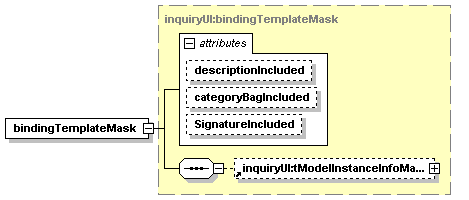
The bindingTemplateMask structure specifies the mask of the binding template of the outputFormat. Optional attributes define which elements will be returned in the entityDetail
businessEntityMask Locate
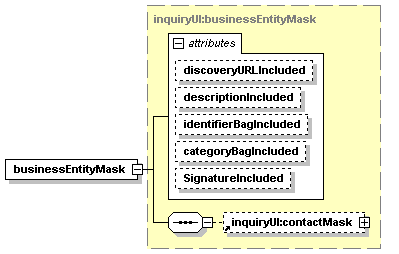
Table 44. Attributes
| Attribute | Required |
|---|---|
| discoveryURLIncluded | No |
| descriptionIncluded | No |
| identifierBagIncluded | No |
| categoryBagIncluded | No |
| SignatureIncluded | No |
The businessEntityMask structure specifies the mask of the business entity of the outputFormat. It also include a contactMask. Optional attributes define which elements will be returned in the entityDetail.
businessServiceMask Locate

The businessServiceMask structure specifies the mask of the business service of the outputFormat. Optional attributes define which elements will be returned in the entityDetail.
contactMask Locate
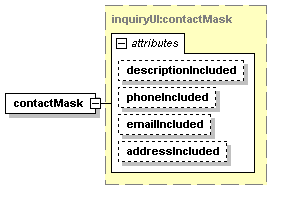
The contactMask structure specifies the submask of the business entity mask of the outputFormat. Optional attributes define which elements will be returned in the entityDetail
entityDetail Locate
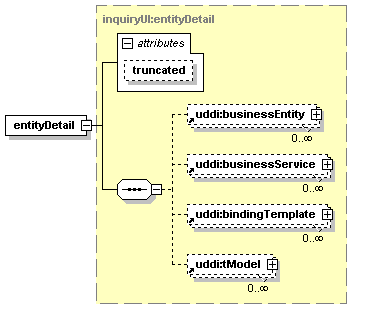
The entityDetail structure is returned by the get_entityDetail operation. The attribute truncated indicates a truncated result list.
outputFormat Locate
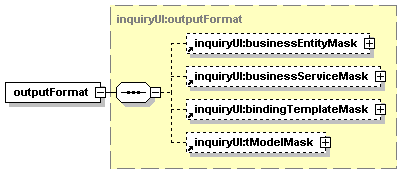
The outputFormat is a mask for data to be returned and can prune returned structures. The output format is defined by the following arguments.
tModelInstanceInfoMask Locate
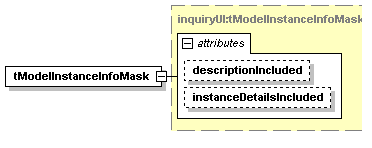
The tModelInstanceInfoMask structure specifies the mask of the tModel instance info of the outputFormat. Optional attributes define which elements will be returned in the entityDetail
tModelMask Locate
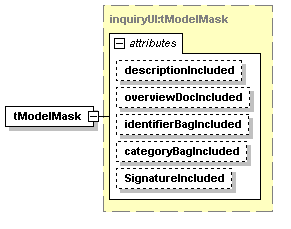
The tModelMask structure specifies the mask of the tModel of the outputFormat. Optional attributes define which elements will be returned in the entityDetail
Operations Locate
get_entityDetail Locate
This is the core operation of the Inquiry UI API.
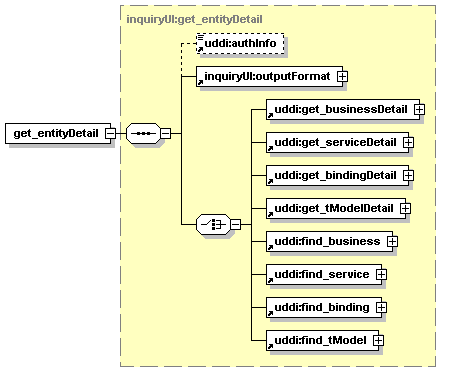
uddi:authInfo - This optional argument is an element that contains an authentication token.
uddi:get_businessDetail, uddi:get_bindingDetail, uddi:get_tModelDetail, uddi:find_business, uddi:find_service, uddi:find_binding, uddi:find_tModel - standard UDDI v3 structures.
Upon successful completion, an entityDetail structure is returned.
WSDL Locate
You can find the WSDL specification in the file inquiryUI.wsdl.
API Endpoint Locate
You can find the Inquiry UI API endpoint at http://<host name>:<port>/uddi/inquiryUI.
Java Locate
Java API is generated directly from WSDL. You are encouraged to browse org.systinet.uddi.client.v3.ui.InquiryUIApi.